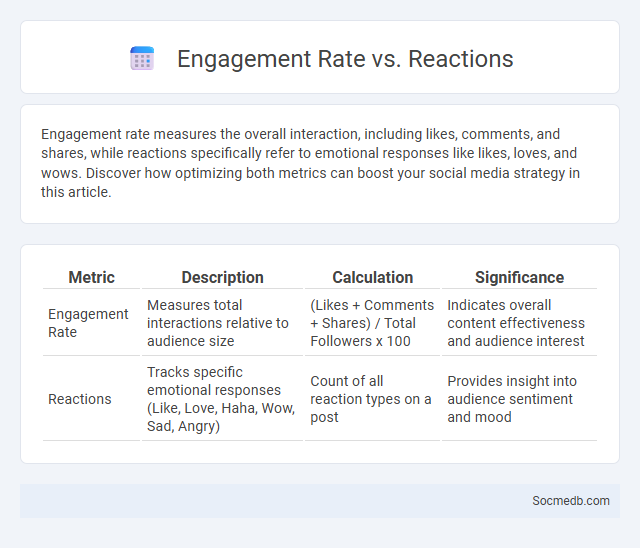
Photo illustration: Engagement Rate vs Reactions
Engagement rate measures the overall interaction, including likes, comments, and shares, while reactions specifically refer to emotional responses like likes, loves, and wows. Discover how optimizing both metrics can boost your social media strategy in this article.
Table of Comparison
| Metric | Description | Calculation | Significance |
|---|---|---|---|
| Engagement Rate | Measures total interactions relative to audience size | (Likes + Comments + Shares) / Total Followers x 100 | Indicates overall content effectiveness and audience interest |
| Reactions | Tracks specific emotional responses (Like, Love, Haha, Wow, Sad, Angry) | Count of all reaction types on a post | Provides insight into audience sentiment and mood |
Understanding Engagement Rate: Definition and Importance
Engagement rate measures the level of interaction your audience has with your social media content, calculated by dividing total engagements (likes, comments, shares) by total followers or impressions. This metric is crucial for evaluating content effectiveness and audience connection, helping you refine your social media strategy. Tracking your engagement rate provides insights into what resonates with your followers, boosting brand visibility and loyalty.
What Are Reactions? Types and Significance
Reactions on social media are interactive icons that allow users to express emotions quickly, such as likes, loves, laughs, or sads, enhancing engagement beyond simple comments. Various platforms offer distinct reaction types like Facebook's six emoji reactions and LinkedIn's professional endorsements, each serving to convey specific sentiments or feedback. Understanding these reactions can help you gauge audience sentiment efficiently and tailor your content strategy to boost interaction and connection.
Engagement Rate vs Reactions: Key Differences
Engagement rate measures the overall interaction a post receives relative to its audience size, encompassing likes, comments, shares, and clicks, while reactions specifically refer to the emotional responses users express, such as likes, loves, or angry faces. High engagement rates indicate broad user involvement and content resonance beyond surface-level reactions. Brands and marketers analyze both metrics to gauge audience connection and refine content strategies for maximizing reach and emotional impact.
How Engagement Rate Is Calculated
Engagement rate on social media is calculated by dividing the total number of interactions, including likes, comments, shares, and clicks, by the total number of followers or impressions, then multiplying by 100 to get a percentage. This metric provides insight into how actively Your audience interacts with content relative to its reach or follower base. Understanding this ratio helps optimize posting strategies and measure content effectiveness across platforms.
Measuring Reactions: Metrics and Tools
Measuring reactions on social media involves tracking key metrics such as likes, shares, comments, and engagement rates to gauge audience response accurately. Tools like Google Analytics, Hootsuite, and Sprout Social provide in-depth analysis and real-time data to help optimize your content strategy. Your ability to interpret these metrics enables targeted improvements, maximizing reach and impact across platforms.
Why Engagement Rate Matters More Than Reactions
Engagement rate is a crucial metric because it reflects the quality of interactions between your audience and content, going beyond superficial reactions such as likes or shares. It measures meaningful actions like comments, shares, and clicks that indicate genuine interest and connection with your brand. Focusing on engagement rate helps you tailor your social media strategy to build a loyal community and achieve long-term growth.
When Reactions Matter Most for Brands
Reactions on social media become crucial for brands during product launches, crisis management, and major marketing campaigns when consumer engagement directly influences brand perception and reach. Your brand's ability to promptly analyze and respond to these reactions can enhance customer loyalty and mitigate negative backlash. Monitoring sentiment and interaction metrics enables strategic adjustments that maximize impact during these critical moments.
Interpreting Engagement Rate vs Reactions Data
Engagement rate measures the percentage of interactions such as likes, comments, and shares relative to total followers, providing a holistic view of audience involvement. In contrast, reactions data focuses solely on specific emotional responses like likes, loves, or angry faces, revealing audience sentiment but not overall activity. Analyzing both metrics together delivers a comprehensive understanding of content performance and user sentiment on social media platforms.
Optimizing Content for High Engagement Rate and Reactions
Crafting compelling visuals and concise, authentic captions boosts your content's visibility and encourages audience interaction. Utilizing trending hashtags and posting during peak engagement hours amplifies reach and reaction rates. You can enhance connection by tailoring content to your specific audience's interests, sparking meaningful conversations and sustained engagement.
Choosing the Right Metric: Engagement Rate or Reactions?
Choosing the right metric to evaluate social media performance depends on the campaign goals, with engagement rate offering a comprehensive measure by combining likes, comments, shares, and clicks relative to follower count. Reactions indicate emotional responses and are valuable for understanding audience sentiment but may not fully capture interaction depth or content reach. Prioritizing engagement rate helps marketers gauge overall audience involvement, while reactions provide insight into the quality of content resonance.
 socmedb.com
socmedb.com